Shichao Zhang
Guangxi Normal University
DeNoise: Learning Robust Graph Representations for Unsupervised Graph-Level Anomaly Detection
Nov 06, 2025Abstract:With the rapid growth of graph-structured data in critical domains, unsupervised graph-level anomaly detection (UGAD) has become a pivotal task. UGAD seeks to identify entire graphs that deviate from normal behavioral patterns. However, most Graph Neural Network (GNN) approaches implicitly assume that the training set is clean, containing only normal graphs, which is rarely true in practice. Even modest contamination by anomalous graphs can distort learned representations and sharply degrade performance. To address this challenge, we propose DeNoise, a robust UGAD framework explicitly designed for contaminated training data. It jointly optimizes a graph-level encoder, an attribute decoder, and a structure decoder via an adversarial objective to learn noise-resistant embeddings. Further, DeNoise introduces an encoder anchor-alignment denoising mechanism that fuses high-information node embeddings from normal graphs into all graph embeddings, improving representation quality while suppressing anomaly interference. A contrastive learning component then compacts normal graph embeddings and repels anomalous ones in the latent space. Extensive experiments on eight real-world datasets demonstrate that DeNoise consistently learns reliable graph-level representations under varying noise intensities and significantly outperforms state-of-the-art UGAD baselines.
Uncertainty-Aware Graph Neural Networks: A Multi-Hop Evidence Fusion Approach
Jun 16, 2025Abstract:Graph neural networks (GNNs) excel in graph representation learning by integrating graph structure and node features. Existing GNNs, unfortunately, fail to account for the uncertainty of class probabilities that vary with the depth of the model, leading to unreliable and risky predictions in real-world scenarios. To bridge the gap, in this paper, we propose a novel Evidence Fusing Graph Neural Network (EFGNN for short) to achieve trustworthy prediction, enhance node classification accuracy, and make explicit the risk of wrong predictions. In particular, we integrate the evidence theory with multi-hop propagation-based GNN architecture to quantify the prediction uncertainty of each node with the consideration of multiple receptive fields. Moreover, a parameter-free cumulative belief fusion (CBF) mechanism is developed to leverage the changes in prediction uncertainty and fuse the evidence to improve the trustworthiness of the final prediction. To effectively optimize the EFGNN model, we carefully design a joint learning objective composed of evidence cross-entropy, dissonance coefficient, and false confident penalty. The experimental results on various datasets and theoretical analyses demonstrate the effectiveness of the proposed model in terms of accuracy and trustworthiness, as well as its robustness to potential attacks. The source code of EFGNN is available at https://github.com/Shiy-Li/EFGNN.
A Novel Generative Model with Causality Constraint for Mitigating Biases in Recommender Systems
May 22, 2025Abstract:Accurately predicting counterfactual user feedback is essential for building effective recommender systems. However, latent confounding bias can obscure the true causal relationship between user feedback and item exposure, ultimately degrading recommendation performance. Existing causal debiasing approaches often rely on strong assumptions-such as the availability of instrumental variables (IVs) or strong correlations between latent confounders and proxy variables-that are rarely satisfied in real-world scenarios. To address these limitations, we propose a novel generative framework called Latent Causality Constraints for Debiasing representation learning in Recommender Systems (LCDR). Specifically, LCDR leverages an identifiable Variational Autoencoder (iVAE) as a causal constraint to align the latent representations learned by a standard Variational Autoencoder (VAE) through a unified loss function. This alignment allows the model to leverage even weak or noisy proxy variables to recover latent confounders effectively. The resulting representations are then used to improve recommendation performance. Extensive experiments on three real-world datasets demonstrate that LCDR consistently outperforms existing methods in both mitigating bias and improving recommendation accuracy.
Generative Physical AI in Vision: A Survey
Jan 19, 2025



Abstract:Generative Artificial Intelligence (AI) has rapidly advanced the field of computer vision by enabling machines to create and interpret visual data with unprecedented sophistication. This transformation builds upon a foundation of generative models to produce realistic images, videos, and 3D or 4D content. Traditionally, generative models primarily focus on visual fidelity while often neglecting the physical plausibility of generated content. This gap limits their effectiveness in applications requiring adherence to real-world physical laws, such as robotics, autonomous systems, and scientific simulations. As generative AI evolves to increasingly integrate physical realism and dynamic simulation, its potential to function as a "world simulator" expands-enabling the modeling of interactions governed by physics and bridging the divide between virtual and physical realities. This survey systematically reviews this emerging field of physics-aware generative AI in computer vision, categorizing methods based on how they incorporate physical knowledge-either through explicit simulation or implicit learning. We analyze key paradigms, discuss evaluation protocols, and identify future research directions. By offering a comprehensive overview, this survey aims to help future developments in physically grounded generation for vision. The reviewed papers are summarized at https://github.com/BestJunYu/Awesome-Physics-aware-Generation.
Toward Fair Graph Neural Networks Via Dual-Teacher Knowledge Distillation
Nov 30, 2024Abstract:Graph Neural Networks (GNNs) have demonstrated strong performance in graph representation learning across various real-world applications. However, they often produce biased predictions caused by sensitive attributes, such as religion or gender, an issue that has been largely overlooked in existing methods. Recently, numerous studies have focused on reducing biases in GNNs. However, these approaches often rely on training with partial data (e.g., using either node features or graph structure alone), which can enhance fairness but frequently compromises model utility due to the limited utilization of available graph information. To address this tradeoff, we propose an effective strategy to balance fairness and utility in knowledge distillation. Specifically, we introduce FairDTD, a novel Fair representation learning framework built on Dual-Teacher Distillation, leveraging a causal graph model to guide and optimize the design of the distillation process. Specifically, FairDTD employs two fairness-oriented teacher models: a feature teacher and a structure teacher, to facilitate dual distillation, with the student model learning fairness knowledge from the teachers while also leveraging full data to mitigate utility loss. To enhance information transfer, we incorporate graph-level distillation to provide an indirect supplement of graph information during training, as well as a node-specific temperature module to improve the comprehensive transfer of fair knowledge. Experiments on diverse benchmark datasets demonstrate that FairDTD achieves optimal fairness while preserving high model utility, showcasing its effectiveness in fair representation learning for GNNs.
Leaning Time-Varying Instruments for Identifying Causal Effects in Time-Series Data
Nov 26, 2024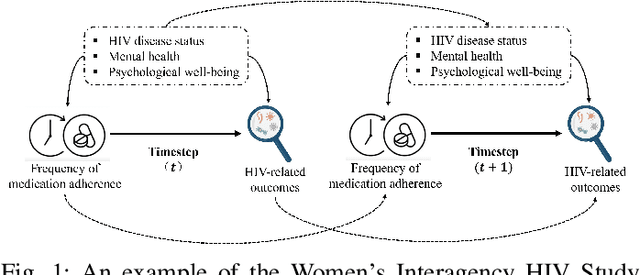
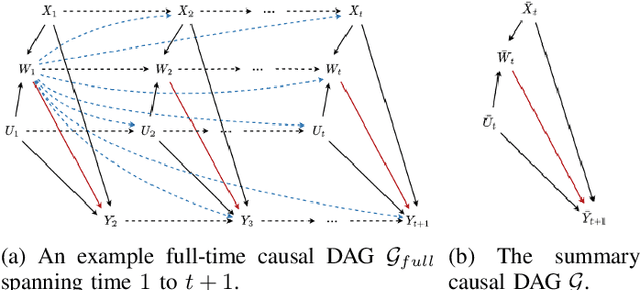
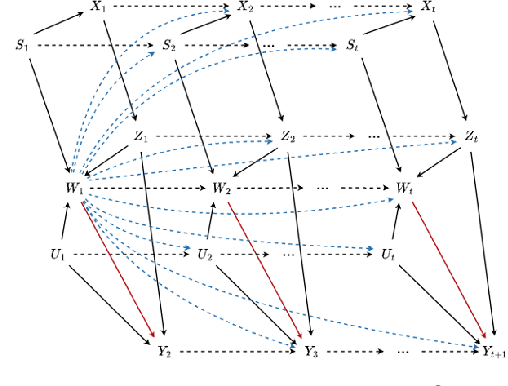
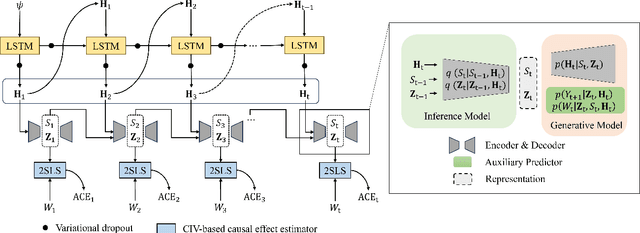
Abstract:Querying causal effects from time-series data is important across various fields, including healthcare, economics, climate science, and epidemiology. However, this task becomes complex in the existence of time-varying latent confounders, which affect both treatment and outcome variables over time and can introduce bias in causal effect estimation. Traditional instrumental variable (IV) methods are limited in addressing such complexities due to the need for predefined IVs or strong assumptions that do not hold in dynamic settings. To tackle these issues, we develop a novel Time-varying Conditional Instrumental Variables (CIV) for Debiasing causal effect estimation, referred to as TDCIV. TDCIV leverages Long Short-Term Memory (LSTM) and Variational Autoencoder (VAE) models to disentangle and learn the representations of time-varying CIV and its conditioning set from proxy variables without prior knowledge. Under the assumptions of the Markov property and availability of proxy variables, we theoretically establish the validity of these learned representations for addressing the biases from time-varying latent confounders, thus enabling accurate causal effect estimation. Our proposed TDCIV is the first to effectively learn time-varying CIV and its associated conditioning set without relying on domain-specific knowledge.
UIFormer: A Unified Transformer-based Framework for Incremental Few-Shot Object Detection and Instance Segmentation
Nov 13, 2024



Abstract:This paper introduces a novel framework for unified incremental few-shot object detection (iFSOD) and instance segmentation (iFSIS) using the Transformer architecture. Our goal is to create an optimal solution for situations where only a few examples of novel object classes are available, with no access to training data for base or old classes, while maintaining high performance across both base and novel classes. To achieve this, We extend Mask-DINO into a two-stage incremental learning framework. Stage 1 focuses on optimizing the model using the base dataset, while Stage 2 involves fine-tuning the model on novel classes. Besides, we incorporate a classifier selection strategy that assigns appropriate classifiers to the encoder and decoder according to their distinct functions. Empirical evidence indicates that this approach effectively mitigates the over-fitting on novel classes learning. Furthermore, we implement knowledge distillation to prevent catastrophic forgetting of base classes. Comprehensive evaluations on the COCO and LVIS datasets for both iFSIS and iFSOD tasks demonstrate that our method significantly outperforms state-of-the-art approaches.
Multi-Cause Deconfounding for Recommender Systems with Latent Confounders
Oct 16, 2024



Abstract:In recommender systems, various latent confounding factors (e.g., user social environment and item public attractiveness) can affect user behavior, item exposure, and feedback in distinct ways. These factors may directly or indirectly impact user feedback and are often shared across items or users, making them multi-cause latent confounders. However, existing methods typically fail to account for latent confounders between users and their feedback, as well as those between items and user feedback simultaneously. To address the problem of multi-cause latent confounders, we propose a multi-cause deconfounding method for recommender systems with latent confounders (MCDCF). MCDCF leverages multi-cause causal effect estimation to learn substitutes for latent confounders associated with both users and items, using user behaviour data. Specifically, MCDCF treats the multiple items that users interact with and the multiple users that interact with items as treatment variables, enabling it to learn substitutes for the latent confounders that influence the estimation of causality between users and their feedback, as well as between items and user feedback. Additionally, we theoretically demonstrate the soundness of our MCDCF method. Extensive experiments on three real-world datasets demonstrate that our MCDCF method effectively recovers latent confounders related to users and items, reducing bias and thereby improving recommendation accuracy.
Towards Fair Graph Representation Learning in Social Networks
Oct 15, 2024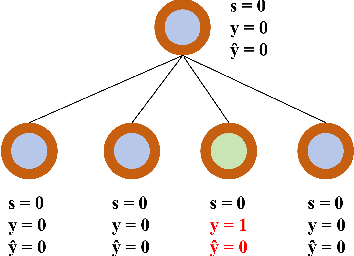
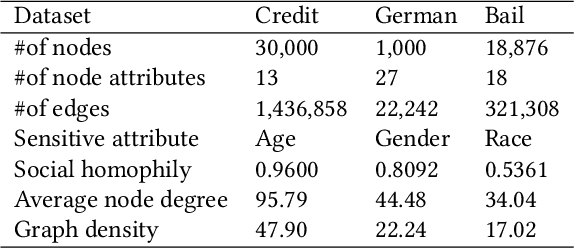
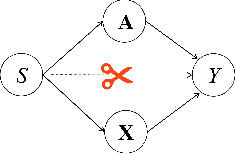
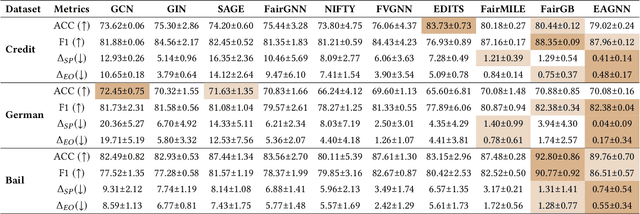
Abstract:With the widespread use of Graph Neural Networks (GNNs) for representation learning from network data, the fairness of GNN models has raised great attention lately. Fair GNNs aim to ensure that node representations can be accurately classified, but not easily associated with a specific group. Existing advanced approaches essentially enhance the generalisation of node representation in combination with data augmentation strategy, and do not directly impose constraints on the fairness of GNNs. In this work, we identify that a fundamental reason for the unfairness of GNNs in social network learning is the phenomenon of social homophily, i.e., users in the same group are more inclined to congregate. The message-passing mechanism of GNNs can cause users in the same group to have similar representations due to social homophily, leading model predictions to establish spurious correlations with sensitive attributes. Inspired by this reason, we propose a method called Equity-Aware GNN (EAGNN) towards fair graph representation learning. Specifically, to ensure that model predictions are independent of sensitive attributes while maintaining prediction performance, we introduce constraints for fair representation learning based on three principles: sufficiency, independence, and separation. We theoretically demonstrate that our EAGNN method can effectively achieve group fairness. Extensive experiments on three datasets with varying levels of social homophily illustrate that our EAGNN method achieves the state-of-the-art performance across two fairness metrics and offers competitive effectiveness.
Personalized Quantum Federated Learning for Privacy Image Classification
Oct 03, 2024



Abstract:Quantum federated learning has brought about the improvement of privacy image classification, while the lack of personality of the client model may contribute to the suboptimal of quantum federated learning. A personalized quantum federated learning algorithm for privacy image classification is proposed to enhance the personality of the client model in the case of an imbalanced distribution of images. First, a personalized quantum federated learning model is constructed, in which a personalized layer is set for the client model to maintain the personalized parameters. Second, a personalized quantum federated learning algorithm is introduced to secure the information exchanged between the client and server.Third, the personalized federated learning is applied to image classification on the FashionMNIST dataset, and the experimental results indicate that the personalized quantum federated learning algorithm can obtain global and local models with excellent performance, even in situations where local training samples are imbalanced. The server's accuracy is 100% with 8 clients and a distribution parameter of 100, outperforming the non-personalized model by 7%. The average client accuracy is 2.9% higher than that of the non-personalized model with 2 clients and a distribution parameter of 1. Compared to previous quantum federated learning algorithms, the proposed personalized quantum federated learning algorithm eliminates the need for additional local training while safeguarding both model and data privacy.It may facilitate broader adoption and application of quantum technologies, and pave the way for more secure, scalable, and efficient quantum distribute machine learning solutions.
 Add to Chrome
Add to Chrome Add to Firefox
Add to Firefox Add to Edge
Add to Edge